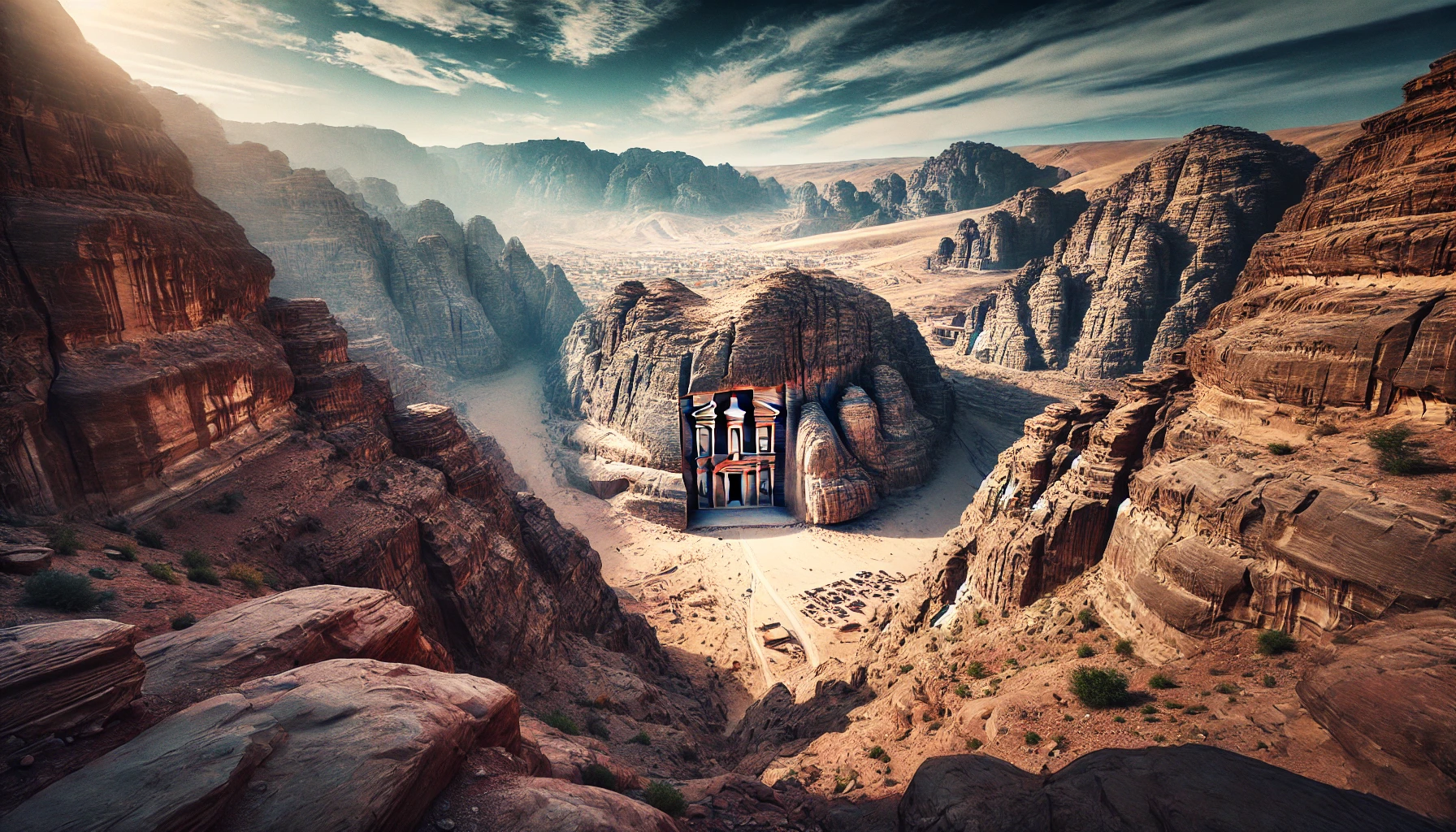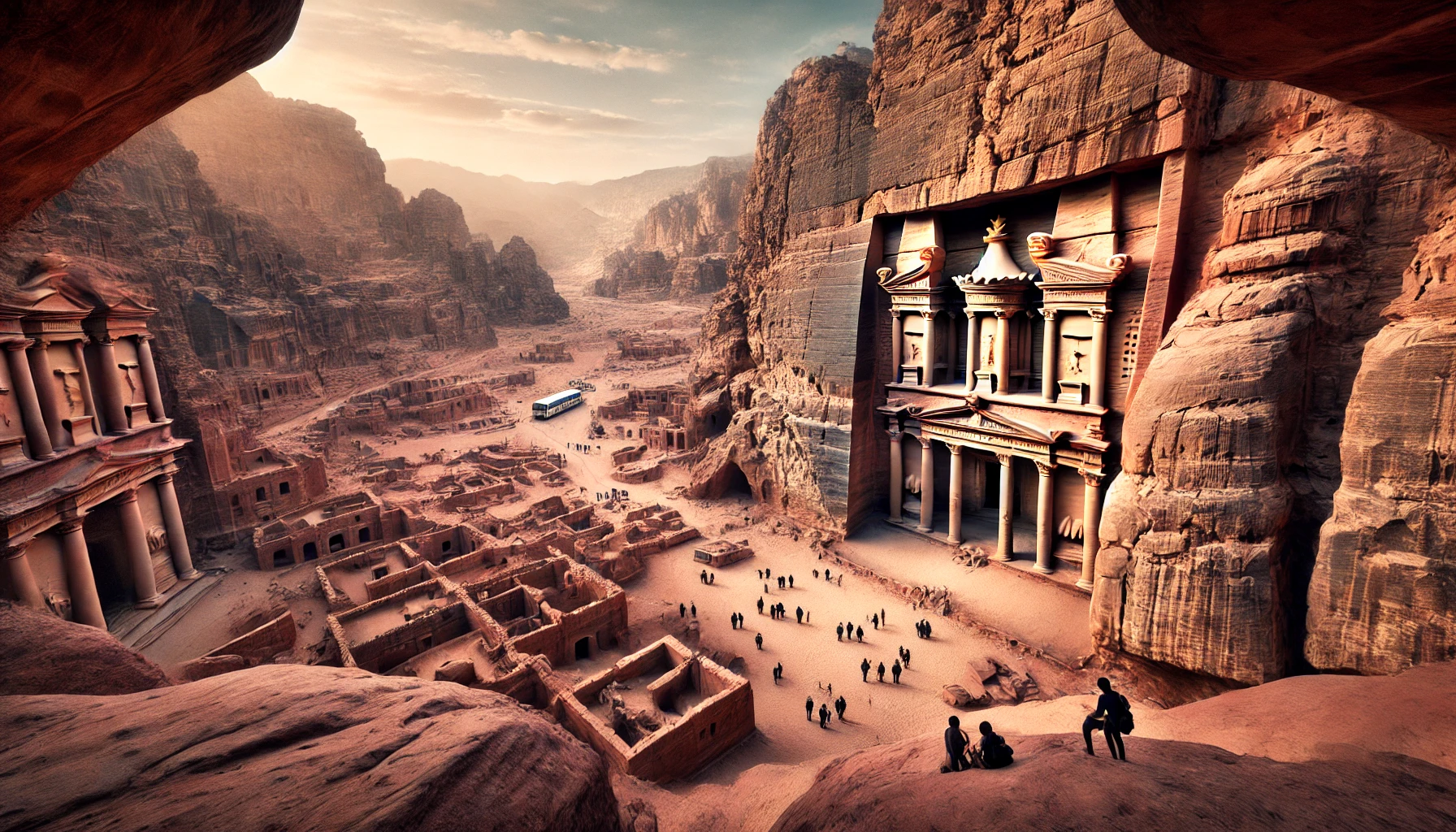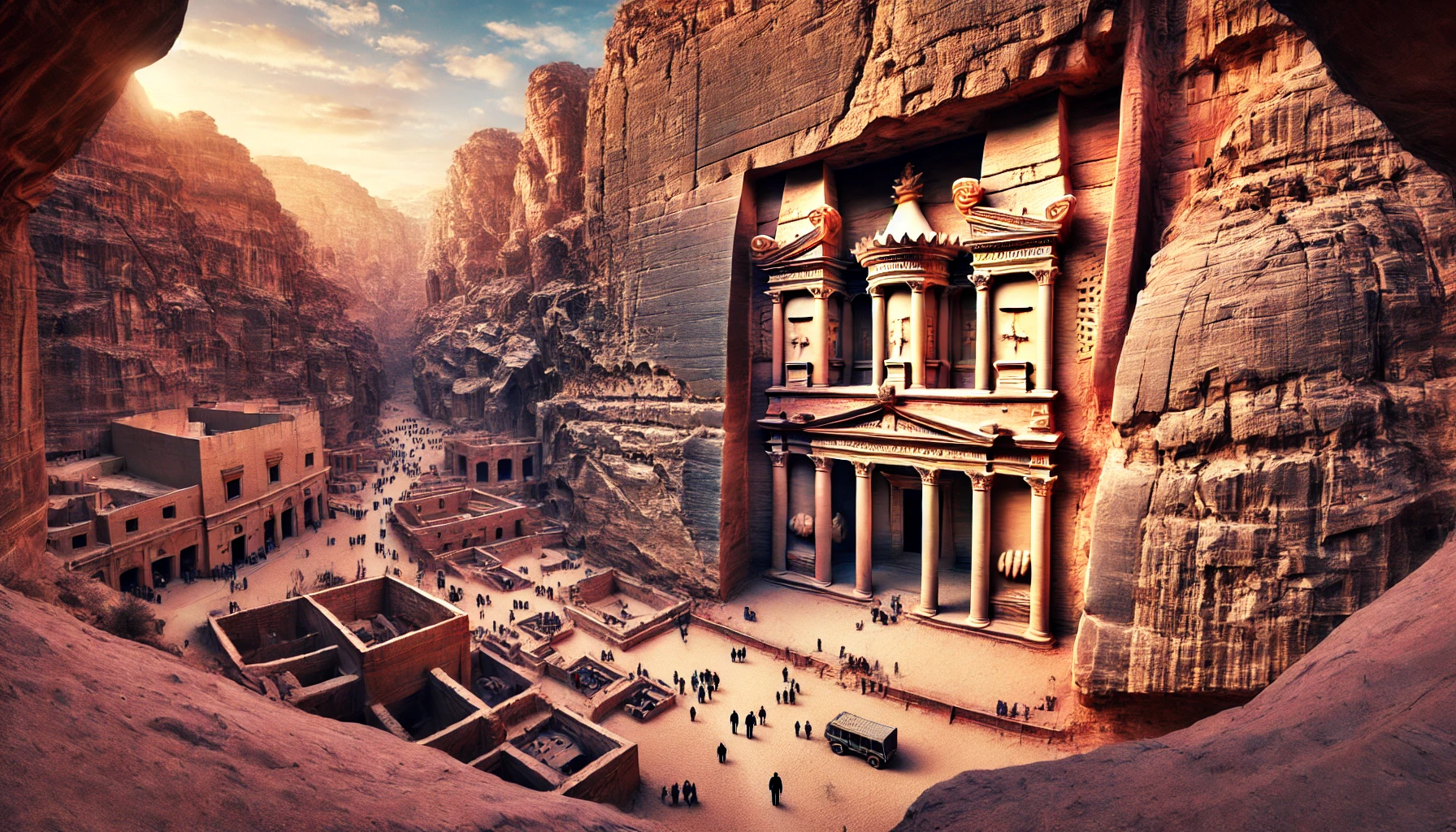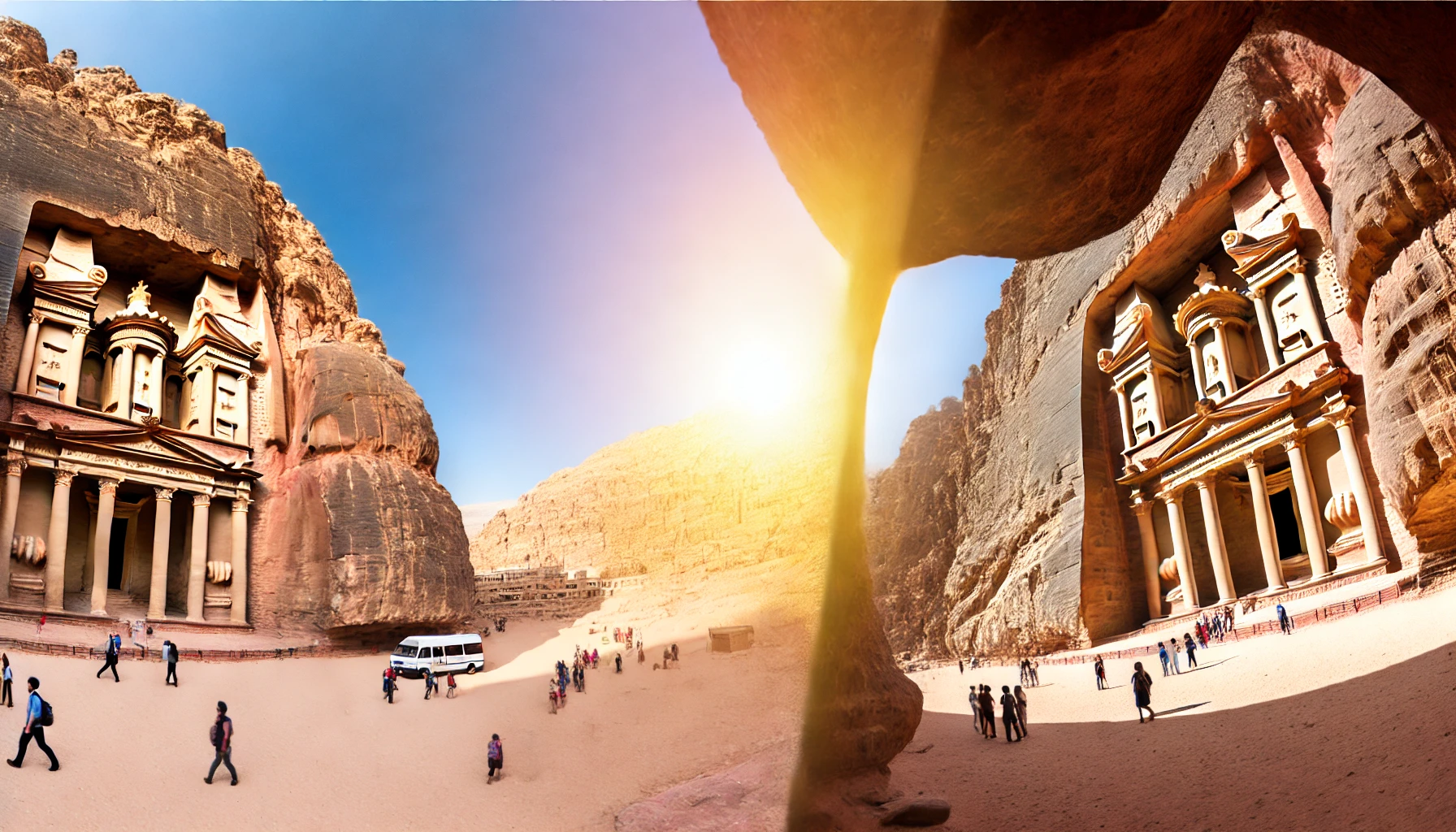Petra is one of Jordan’s most famous historical and archaeological sites and is considered one of the most impressive ancient cities in the world. Renowned for its breathtaking structures carved into the rock, unique architecture, and historical significance, Petra was inscribed on the UNESCO World Heritage list in 1985 and has also been named one of the New Seven Wonders of the World. Founded by the Nabataeans in the 4th century BCE, this ancient city became one of the most important trade centers of its time and has evolved into a popular tourist destination, attracting millions of visitors today.
Where is Petra (Jordan) Located?

Petra is located in the southern part of Jordan, within the Ma’an Governorate. It lies approximately 240 kilometers south of the capital, Amman, and is situated near the small town of Wadi Musa in a secluded valley surrounded by rugged mountains northeast of the Red Sea. Due to its geographic location, Petra has a desert climate and is characterized by its isolated appearance, with structures carved into towering rock faces. Historically, Petra thrived as a major trade hub, strategically positioned at the crossroads of ancient trade routes.
Geographic Location and Climate
Petra is nestled in the southern region of Jordan, northeast of the Red Sea, near the town of Wadi Musa. Hidden among the mountains, this ancient city is enveloped by a dramatic desert landscape. The region experiences a desert climate, with hot and dry summers, and cold, rainy winters. Spring and autumn, with their milder weather, are considered the best seasons for visiting.
The History of Petra

The Nabataean Era and Foundation
Petra was founded in the 4th century BCE by the Nabataeans, an Arab people. Due to its location at the crossroads of trade routes such as the Silk Road, it became a significant trade center during this period. The Nabataeans equipped Petra with water management systems, transforming it into a well-protected city and establishing it as a key hub on the Spice Route. Petra stood out as a symbol of wealth and prosperity in its time.
The Roman Empire Period
In 106 CE, Petra was annexed by the Roman Empire. During this era, the city continued to thrive, influenced by Roman culture and architecture. Some structures from the Roman period, still standing today, reflect this cultural exchange. The Romans added theaters, baths, and aqueducts, which enhanced the city’s infrastructure and grandeur.
Byzantine and Islamic Periods
After the 5th century, Petra became part of the Byzantine Empire. With the spread of Christianity, several churches were built within the city. However, changes in trade routes and a series of earthquakes led to Petra’s gradual decline. Following the rise of Islam, Petra was largely forgotten for centuries.
Rediscovery by Johann Burckhardt
In 1812, Petra was rediscovered by Swiss explorer Johann Ludwig Burckhardt. Guided by information from local Bedouins, Burckhardt successfully reached the site and introduced this ancient city to the Western world. Following its rediscovery, Petra became a focal point for archaeologists and has since attracted millions of visitors worldwide, making it a globally renowned tourist destination.
The Structures and Highlights of Petra

A City Carved into History
Petra is renowned for its temples, tombs, theaters, and water systems carved into the rocks. Known as the “Rose City” due to the colorful rock formations, Petra showcases extraordinary architectural ingenuity.
Al-Khazneh (The Treasury)
The most famous structure in Petra, Al-Khazneh (The Treasury), features an eye-catching design with columns and carvings reminiscent of Ancient Greek architecture. Standing about 40 meters tall, this impressive structure is carved into sandstone cliffs. It is believed to have been built as a tomb for Nabataean King Aretas III.
The Amphitheater
One of Petra’s most striking structures is the Roman Theater. Carved into the rocks during the Roman period, it has a seating capacity of 4,000 people. This Roman-style theater highlights Petra’s significance as a cultural and artistic hub.
The Royal Tombs
The Royal Tombs are grand and elaborate burial sites located on Petra’s high cliffs. Among them are the Silk Tomb, Urn Tomb, and Palace Tomb, which were built for Nabataean kings and individuals of high status. These tombs are some of the finest examples of Petra’s extraordinary architecture.
Ad-Deir (The Monastery)
Located in the higher areas of Petra, Ad-Deir (The Monastery) is even larger than The Treasury. Standing approximately 45 meters tall, it was used as an ancient temple. Visitors must climb about 800 steps to reach this site, but the effort is rewarded with stunning views of the surrounding landscape.
Petra’s Cultural and Archaeological Significance
Petra reflects the architectural brilliance of the Nabataeans and underscores the importance of ancient trade routes. Its advanced water management systems are an impressive example of how the city flourished in an arid climate. The structures in Petra represent a blend of Nabataean art and Roman architecture, highlighting its immense cultural value. The tombs and temples in the ancient city reveal insights into the religious beliefs and societal structure of the time.
The Best Time to Visit Petra

The ideal time to visit Petra is during spring (March-May) and autumn (September-November). The weather during these seasons is mild, offering visitors a more comfortable experience. Summers in the region can be extremely hot, while winter evenings can get quite cold. For the best experience, visiting Petra in the early morning or late afternoon is recommended.
Entrance Fees
- Single-Day Ticket: 50 Jordanian Dinars (approximately 70 USD)
- Two-Day Ticket: 55 Jordanian Dinars
- Three-Day Ticket: 60 Jordanian Dinars
Children under the age of 12 are typically granted free entry.
Guide Services
Guided tours usually last 2-3 hours and cover the main highlights such as the Siq, The Treasury, and The Royal Tombs. These tours provide rich insights into the history, culture, and archaeology of the site.
- Guided tours can be arranged for groups or private visitors.
- The cost of guided tours varies depending on the type of tour and the guide’s language.
Getting to Petra
- From Amman: Traveling by bus from Amman to Petra takes about 3 hours. Buses usually depart in the morning and arrive in Petra before noon.
- From Aqaba: A bus journey from Aqaba to Petra takes approximately 2 hours.
- By Car: Renting a private vehicle offers more flexibility and is another convenient option for reaching Petra.
Things to Do in Petra
Animal Transport
Animal transport services, including horse-drawn carriages, donkeys, and camels, are available in this city. While these services are typically free, tipping is customary.
Extra Tours
For those wishing to explore lesser-known areas, self-guided or additional guided tours can be arranged. Every corner of Petra offers a unique historical discovery.
Important Tips
- Walking Shoes: This city covers a vast area, so wearing comfortable walking shoes is essential.
- Sunscreen and Water: Given Petra’s sunny climate, bringing plenty of water and using sunscreen is crucial for staying hydrated and protected.
